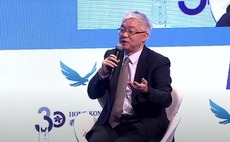
GP profile: Hosen Capital

From renminbi funds to US dollar funds and from growth equity to buyouts, Hosen Capital has been through several evolutions in its first decade. Meeting China’s food needs remains a constant
When Hosen Capital needed a new CEO of Tous Les Jours, it wasted no time in reaching out to Haitao Li. A 16-year veteran of China Resources Group, Li had spent nearly a decade running Pacific Coffee. The Hosen team got to know him when researching potential investment targets in the food and beverage space, several years before Tous Les Jours appeared on the radar.
The bakery chain wasn't in great shape. Korean conglomerate CJ Group had acquired the China master franchise for Tous Le Jours and launched it in 2005, growing to 200 outlets. Subsequently, the business meandered. It failed to keep up with local market changes, made some poor strategic decisions, and by the time Hosen arrived on the scene last year, the store count had fallen to 100.
The private equity firm took a majority stake and implemented a turnaround plan that involves focusing on best-selling baked goods and beverage products, building out takeaway, e-commerce, and membership services, and concentrating on Beijing, Shanghai, and Shenzhen. There will be 200 outlets by year-end, including flagship, standard, and mini stores. Most will be franchised, but on an individual basis as opposed to the previous province-by-province approach.
"This is such a dynamic market and large conglomerates are often slow to respond. When Hosen got involved with Tous Les Jours, it was more from a strategic or investment perspective. Execution is left to the management team," says Li. "We talk about business optimization every day. Once you have an efficient model, it becomes so much easier."
Hosen was able to act swiftly – "We decided quickly that we could turn it around," notes Alex Zhang, the firm's founding partner – thanks to a combination of domain expertise and knowing where to find the right talent. The firm was bold enough to replace every senior executive at Tous Les Jours, despite a limited supply of local management talent with international-level skills and experience.
"In the US, large PE firms find professional CEOs who can assemble teams. That's not the case in China. We do talent mapping for every investment, and when we do replace entire teams, we learn to work with people rather than just telling them what to do," says Zhang.
"However, a new generation of executives with multinational experience has emerged in China. They have the right training, a good combination of professional skills and local insights, and truly ambitious to want to the top driving executives."
This is one of several big-picture changes Hosen sees in China. Harnessed in tandem with rising disposable incomes, evolving consumer tastes, and more situations where investors can take control of assets, it may help accelerate the private equity firm's mid-market food buyout thesis.
Meeting of minds
As a sector specialist targeting control and growth equity investments in China's food brands and the supply chains and technologies that support them – including overseas businesses that feed China – Hosen is a rarity. The firm is essentially the product of a meeting of minds in 2010.
Chris Wang had left his number two position at Chinese agribusiness giant New Hope Group and was looking for a new challenge. Private equity appealed. Zhang had returned to China after 13 years overseas in consulting roles and with a start-up in Silicon Valley. He launched two more start-ups in China but hankered after a move to the investment side. They were introduced by mutual friends.
"We had a common goal and strong personal chemistry, and that was the start of an 11-year journey" Zhang recalls. "It was an intellectual journey as well. We looked at how private equity had evolved with KKR and Blackstone, and we also looked at how several strategic players had built their businesses. We were interested in industry consolidation, and we wanted to grow Hosen as an independent private equity firm with a wider focus on an ecosystem, not a corporate VC or PE with a narrow focus. "

Nevertheless, the initial years were characterized by minority growth investments, including the likes of hotpot chain Haidilao, infant formula producer China Feihe, online-to-offline local services platform Meituan, and B2B2C catering business Etaoshi. There was also strong support from New Hope. While Hosen has always been operationally independent, New Hope served as anchor LP in the firm's RMB1.3 billion ($188 million) debut fund in 2010.
Even with the introduction of the first US dollar-denominated vehicle – which closed at $128 million in 2012 – New Hope was one of several strategic or quasi-strategic supporters, alongside the likes of Mitsui & Company and Temasek Holdings. "We targeted LPs that understood the food and agriculture space in China – how big it is, why it is structurally interesting, and why Chris and I had a competitive edge in execution," says Zhang.
Hosen raised $440 million for its second US dollar fund in 2017 and $800 million for its third earlier this year. The LP base has become more institutional with each vintage – 80% of the Fund III corpus comes from sovereign wealth funds, pension funds, endowments, asset managers, family offices, and fund-of-funds – but some investors still drew comfort from the firm's strategic connections.
"When we first backed them, the New Hope connection was a huge factor," says on LP that came into the second US dollar fund and re-upped for the third. "I don't think they rely as much on them now, so it's a nice-to-have rather than a must-have. But when they launched it was a must-have. We've backed several China managers where there is a strategic alliance. On one hand, they benefit from the network and the resources. On the other, we must make sure there is full transparency."
Getting comfortable with Hosen involved digging into the economics and studying deal flow and decision making for any suggestion of conflicts of interest. Once those concerns were addressed, Hosen had one key selling point: differentiation.
Plenty of China managers have established themselves in the renminbi space and sought to raise US dollar funds, but the transition isn't necessarily easy. "There must be something special to offset the GP-related risk if they come from a renminbi background, something unique that we don't already have in our portfolio," the LP adds. "Hosen is unique in its positioning. I can't think of any other manager with the same experience and success combing through the food supply chain."
Being different
It helped that the firm's thesis was becoming more focused. The remit was initially food and agriculture, but this narrowed to food because regulation made the pure agriculture space problematic. An early side focus on healthcare was also scaled back.
At the same time, Hosen had made its breakthrough buyout with Kilcoy Pastoral in 2013. The beef processing business – now called Kilcoy Global Foods – had spent 54 years under family ownership and then six years as a portfolio company of two successive private equity firms. Australian exports to China were just taking off and Hosen arrived with a plan to build out the supply channels.
"Our initial plan was to invest in a value-added Chinese company and build a supply chain from Australia into China. While looking at different companies globally, we zoomed into Australia," says Zhang. "Following the acquisition of Kilcoy, we bought Weihai Weidao Foods to close the supply chain loop. Weidao is an important supplier to major Western restaurant chains in China."
Kilcoy was no small undertaking for Hosen. Not only was the firm engaging in its first control transaction, but it was doing so in an economy and business environment far removed from China. Zhang admits many lessons were learned. However, one tactic he stands by is taking time to understand the existing management team, selling them on the Asian growth strategy, and then empowering them to execute it.
"Following the acquisition, we sat down with the Hosen team and devised a three-year strategic plan. We are now on our third plan and our core values and direction haven't changed materially, although we have incorporated new and emerging strategies that complement our core business," says Dean Goode, Kilcoy's CEO, who has been with the business since 2007.
The company's processing plant was upgraded, enabling it to handle high-end wagyu for the retail and foodservice markets as well as for wholesale, and to increase capacity from 750 cattle per day to 2,000. Just within Australia, revenue has grown from A$450 million ($349 million) to A$1.5 billion.
Overall, Kilcoy is generating close to $1.6 billion a year and has established itself as a global operation, primarily through M&A of complementary assets. Ruprecht, an existing customer in the US, was purchased to create an integrated supply chain. In China, Weidao brought processing and supply capacity, while an import business was established in Shanghai for foodservice and retail distribution and an institutional catering company was acquired to serve school, university, and corporate canteens.
There has been a substantial swing from the US to Asia, with China, Japan, and South Korea absorbing 70% of Kilcoy's output. Unfortunately, Kilcoy was one of four companies suspended from selling into China because of souring Canberra-Beijing relations. It shifted processing to other countries to continue supplying the China market. The stand-off dashed near-term plans for an IPO, but it is hoped that business will normalize in due course.
"A lot of companies came to assess us when we were for sale. What stood out about the Hosen team was the homework they had done prior to the due diligence process on the Australian beef industry and how Kilcoy fitted into it, and how Australia was positioned in a global context in terms of export partners and opportunities," says Goode. "They were interested in food production, supply chain, and logistics, and then they understood North Asia very well."
Domain expertise
This gives credence to Zhang's claim that Hosen ventured into Australia having recognized a long-term trend in the premiumization of animal protein and a consequent increase in Chinese demand for beef and lamb. It studied the four leading beef producing nations, narrowed it to the top 30 in Australia, and dismissed one through three because they were too large or inaccessible. Kilcoy was number five.
There was a similar thought process behind the A$1 billion acquisition of Australia-based Real Pet Food in 2017. China's pet food industry has been growing at 30-50% annually in recent years, far outpacing GDP expansion. Hosen divided the industry into five segments: budget, mainstream and premium – much like the US – and then super-premium and ultra-premium. There were no domestic brands in the latter two segments, so the private equity firm looked overseas.
Once again, suppliers were ranked based on China sales and addressable mid-market targets were prioritized. Real Pet Food came in 20th, but it was the highest Australia-based entrant and the global leader in chilled pet food. This was a good fit for Hosen's premiumization thesis, whereby pet owners graduate from dry food to wet food and from there to freeze-dried, chilled, and air-dried.
"I have a database that contains the top 20-25 brands in China in the pet products and services space and I track them once or twice a year, looking at volume growth and whether they would be suitable targets for us," says Leo Li, a senior investment manager at Hosen. "Ten of the 20 are overseas. Seven of those 10 are family-owned or private equity-owned. The rest are part of conglomerates."

In a domestic context, Li describes the research that underpins the firm's investments as focused on identifying industry concentration 2-3 years before it happens. As the trend gathers momentum, Hosen approaches pre-identified targets and shares its mapping of the competitive dynamics.
This strengthens the subsequent pitch, especially when made to family owners: bringing in a private equity investor as a majority partner will give your company the financial and operational resources to take advantage of consolidation rather than be consumed by it. Li is currently working on a pet food deal in which it has taken months the convince the controlling shareholder of the merits of professional management. Ultimately, the idea of their "legacy deteriorating" is the clinching factor.
The Real Pet Food transaction demonstrated two other ways in which Hosen's approach to buyouts is maturing. First, it was large enough to account for one-quarter of Fund II and still leave room for co-investment. New Hope, Temasek, and JD.com were among the participants. JD is significant as the second-largest retailer in a pet food industry that is rapidly shifting online. Its involvement led to workshops with the Real Pet Food team intended to accelerate e-commerce efforts.
Hosen has sought to institutionalize these relationships through the establishment of a club, comprising approximately 200 investors and strategic partners, that meets on a quarterly basis. Representatives from Cargill and Mitsui to Meituan and JD attend.
Second, the firm completed due diligence of Real Pet Food's management talent alongside the financial and legal work, enabling it to identify any gaps and figure out who could fill them. Within six months of the deal closing, Li had personally recruited a 10-strong China team, including several candidates he had been tracking since early in the diligence phase. One of them is a senior commercial executive brought in from Mars who has extensive e-commerce experience.
This speed of movement is credited with helping Real Pet Food close its first China sales order seven months after closing. The China business broke even in the first half of 2018, tripled in size in year two, and doubled in year three. It still accounts for a relatively small share of overall revenue.
Growing pains?
The pressures a GP typically faces as fund size increases with each vintage can be split into organizational and investment categories. On the organizational side, the firm is becoming larger in terms of headcount and more layered from a structural perspective. This could impair the quality of decision-making. On the investment side, it is a case of doing more deals, which could dilute returns, or larger deals, which means competing with different GPs for more complex assets.
Hosen's headcount has grown to 30, including 17 investment professionals. Zhang points to the recruitment of food industry veteran Steven Shi in 2016 as evidence of how the firm's buyout capabilities have evolved. There are also dedicated in-house resources to assist portfolio companies across finance and human resources functions, and a digitalization expert is currently being recruited. Operating partners are brought in to work with specific companies as required.
There were eight investments in the first US dollar fund, 12 in the second, and Hosen expects 10-12 in Fund III. This means an increase in deal size, with equity checks in the $100-120 million range. Co-investors will be invited to participate in larger transactions.
"I think there has been a clear evolution in the understanding of deal sourcing, deal structuring, and portfolio management in China," says Zhang. "Deal size isn't that important. The complexity level of a $100 million deal versus a $300 million deal is about the same. If anything, it is easier to do a larger investment because you can afford better management and better advisors."
In this context, Hosen believes that structural change will work in its favor. Deal sizes are likely to be propelled upwards not only by industry growth but also by an ongoing shift from minority to control. Li identifies more private equity-to-private equity transactions – which could benefit Hosen on exit as well as on entry – multinationals divesting their China divisions in the face of rising local competition, and succession planning as the key drivers.
"We see pressure on the first generation of founders because of difficulties getting the second generation to assume control," he says. "That's where we want to play. We have the management capabilities and corporate governance knowledge to manage those situations."
Hosen will continue to plow its furrow within the food space – looking not just at the consumer brands that captive most private equity firms, but also upwards into the supply chains. Zhang draws parallels between past industry consolidation in the US and Europe and the reality confronting corporate China. He sees the swing towards buyouts as an indelible trend, offering Hosen the chance to travel the evolutionary curve he traced for KKR and Blackstone more than a decade ago.
But his outlook stretches further, to emulating global GPs in strategic development as well as in deal type. Credit seems a logical progression – provided the latest PE fund goes well.
"We are $800 million now, so maybe we can raise over $1 billion next time. Once we have more capabilities and more of a track record we can ask if we should have specialized teams doing other things," Zhang says. "It comes down to the ambitions of the team. Private equity depends a lot on people, so we need to have the right incentives and culture for the younger generation."
Latest News
Asian GPs slow implementation of ESG policies - survey
Asia-based private equity firms are assigning more dedicated resources to environment, social, and governance (ESG) programmes, but policy changes have slowed in the past 12 months, in part due to concerns raised internally and by LPs, according to a...
Singapore fintech start-up LXA gets $10m seed round
New Enterprise Associates (NEA) has led a USD 10m seed round for Singapore’s LXA, a financial technology start-up launched by a former Asia senior executive at The Blackstone Group.
India's InCred announces $60m round, claims unicorn status
Indian non-bank lender InCred Financial Services said it has received INR 5bn (USD 60m) at a valuation of at least USD 1bn from unnamed investors including “a global private equity fund.”
Insight leads $50m round for Australia's Roller
Insight Partners has led a USD 50m round for Australia’s Roller, a venue management software provider specializing in family fun parks.








